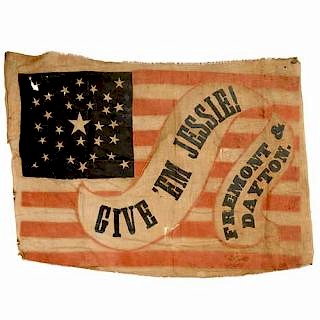The Martyr's Mirror, Early Ephrata Cloister Printing, 1748-1749
About Seller
6270 Este Ave.
Cincinnati , OH 45232
United States
With offices in Cincinnati, Cleveland and Denver, Cowan’s holds over 40 auctions each year, with annual sales exceeding $16M. We reach buyers around the globe, and take pride in our reputation for integrity, customer service and great results. A full-service house, Cowan’s Auctions specializes in Am...Read more
Two ways to bid:
- Leave a max absentee bid and the platform will bid on your behalf up to your maximum bid during the live auction.
- Bid live during the auction and your bids will be submitted real-time to the auctioneer.
Bid Increments
| Price | Bid Increment |
|---|---|
| $0 | $25 |
| $500 | $50 |
| $1,000 | $100 |
| $2,000 | $250 |
| $5,000 | $500 |
| $10,000 | $1,000 |
| $20,000 | $2,500 |
| $50,000 | $5,000 |
| $100,000 | $10,000 |
About Auction
Nov 18, 2016 - Nov 19, 2016
Cowan's Auctions dawnie@cowans.com
- Lot Description
Braght, Thielman Jans Van. (Tieleman Jansz van Braght). Der Blutige Schau-Platz oder Martyrer Spiegel der Tauffs Besinten oder Wehrlosen Christen, Die um des Zeugnutz Jesu ihres Seligmachers willen gelitten haben, und seynd getodtet worden, von Christi Zeit an bis auf das Yahr 1660. (The Bloody Theater or Martyrs Mirror of the Defenseless Christians, who, baptized only upon Confession of Faith, and, who suffered and died for the Testimony of Jesus, their Savior, from the time of Christ to the Year [AD] 1660.) Ephrata (Pennsylvania), Printing and publishing house of the Brotherhood, 1748-1749. Folio (8.5 x 14 in.), leather over inwardly beveled boards, brass corner guards (one missing), leather strap reinforcing top of spine (if there was one on lower spine, now missing), brass clasps on front board, remnants of cloth straps attached to rear board; two title pages (as called for): 56, 478, [iv] (unnumb. first index), [xiv], 950, [x] (unnumb. second index) (1512pp), frontis illustration of John baptising Jesus in the River Jordan, with other images of martyrs being crucified upside down, boiled alive, beheaded, stoned, imprisoned, etc. Moses stands in the lower left corner holding the tablets of commandments. A dove descends from heaven and mythological creatures are scattered about.
In 1732, Johann Conrad Beissel arrived at Cocalico Creek in (what is now) Lancaster County, PA, having split from the Schwarzenau Brethren in Germany. Beissel and his followers established a semi-monastic community (The Camp of the Solitary), a convent (Sister House) and monastery (Brother House) that they called Ephrata. Members were celibate, fundamentalist and held that the seventh day was the Sabbath. There was also a surrounding community of married followers and their families. These communities emphasized hard work, and in addition to subsistence activities (farming, making clothing, etc.), they also established milling, carpentry, papermaking, and printing businesses. They became famous for writing and publishing hymns.
Ephrata emphasized education, and one of the charity works of the brotherhood was education of the children. One of its members, Peter Miller, who became the second prior of the monastery, translated the Declaration of Independence into seven languages at the request of Congress.
In 1745, Jacob Gottschalk of the Mennonite community in Montgomery County ("next door" to Lancaster County), arranged with Ephrata Cloister to translate the Martyrs Mirror, which had been brought from Europe, from Dutch into German. Miller did the primary translation. Fifteen solitary brothers were detailed to the production of the work, which took three years. Four were compositors, four were pressmen; most of the rest worked in the paper mill. It became the largest book printed in America before 1800 on the second German press in the colonies. In most copies, the two volumes, for which two title pages were printed, were bound together (as this copy was). Many of the original 1300 copies were purchased by the Montgomery County Mennonites, although the frontis of Jesus' baptism was left out of their copies because the Mennonites objected to the picture.
A monumental edition, The Martyrs Mirror was later translated into English. It is still beloved in Amish and Mennonite communities. Most homes have a copy in one language or another, from one of many printings. It is still in print and often given as a wedding gift for new Mennonite couples.Leather beginning to dry and crack. The outer hinges have split. However, it is still holding together, and now would be an excellent time for conservation of this historic volume to retain most of its original features.Condition
- Shipping Info
-
SHIPPING. At the request of the buyer, Cowan's will authorize the shipment of purchased items. Shipments usually occur within two weeks after payment has been received. Shipment is generally made via UPS Ground service. Unless buyer gives special instructions, the shipping method shall be at the sole discretion of Cowan's Auctions, Inc.. Cowan's is in no way responsible for the acts or omissions of independent handlers, packers or shippers of purchased items or for any loss, damage or delay from the packing or shipping of any property.
-
- Buyer's Premium



 EUR
EUR CAD
CAD AUD
AUD GBP
GBP MXN
MXN HKD
HKD CNY
CNY MYR
MYR SEK
SEK SGD
SGD CHF
CHF THB
THB













